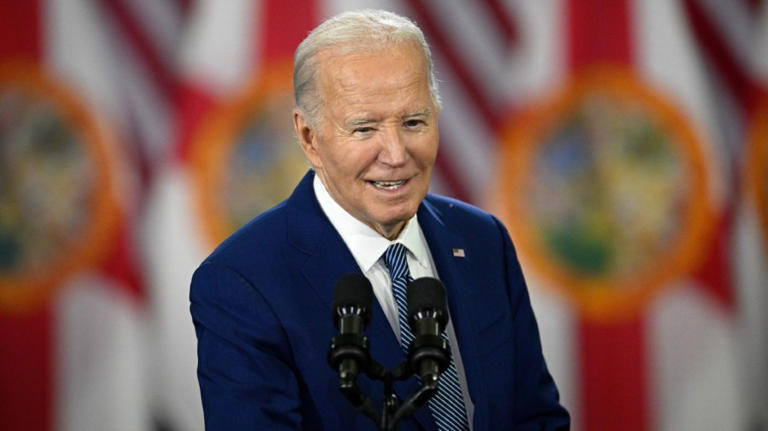Biden campaign, grassroots fundraising, April fundraising, Trump campaign, 2024 election, campaign strategy, battleground states, Joe Biden, Kamala Harris, election polls, campaign donations
Discover how President Biden’s campaign raised $51 million in April, emphasizing grassroots support and strategic investments in key battleground states. Learn about the contrast with the Trump campaign’s approach and the impact of current polling data as the 2024 election approaches.
In a remarkable display of grassroots support, President Joe Biden’s campaign raised $51 million in April, bringing its total on-hand funds to $192 million as it heads into June. Despite falling short of the Trump campaign’s $76 million April haul, Biden’s campaign has emphasized its strong organizational framework and broad base of small-dollar donors as key strengths.

Grassroots Enthusiasm Fuels Biden’s Campaign
The Biden campaign’s April fundraising success is a testament to the sustained enthusiasm among grassroots supporters. Campaign manager Julie Chavez Rodriguez highlighted the critical role of these small-dollar donors in building a robust campaign infrastructure. “April’s haul reflects strong, consistent grassroots enthusiasm for reelecting Joe and Kamala, and is giving us the resources necessary to invest in opening offices, hiring organizers, and communicating across our battleground states in order to mobilize the coalition of voters who will decide this election,” Rodriguez stated.
In contrast to the Trump campaign, which has relied heavily on large fundraising events targeting wealthy donors, the Biden campaign has focused on broadening its base. This strategy has paid off, with the campaign adding 1 million supporters to its email list in April alone. The significance of recurring donations was particularly notable, with these contributions totaling over $5.5 million for the month.
Strategic Investments in Battleground States
Biden’s campaign has strategically allocated its resources to maximize impact in key battleground states. By opening offices and hiring organizers in these crucial areas, the campaign aims to build a formidable ground game that can effectively mobilize voters. This effort is complemented by targeted communication efforts, including a series of television ads that highlight Biden’s record and address contentious issues such as abortion.
The Biden campaign’s focus on reaching minority voters is another critical aspect of its strategy. These voters are expected to play a decisive role in the upcoming election, and the campaign’s efforts to engage with and earn their support are indicative of a broader, more inclusive approach.
A Contrast with the Trump Campaign
While the Biden campaign has made significant strides in building a robust, grassroots-driven operation, the Trump campaign has faced several challenges. Despite raising more money in April, the Trump campaign has struggled with high expenditures, particularly on legal fees related to the former president’s four criminal cases. This financial strain has limited the campaign’s ability to invest in on-the-ground operations and television ads.
Trump campaign officials, however, have downplayed the significance of Biden’s cash advantage. They assert that the former president and his team will have the necessary resources to mount a competitive campaign in November. Nonetheless, the lack of a strong ground game and minimal presence in swing states are notable gaps in the Trump campaign’s strategy.
Polling and the Path to November
Current polling data provides a snapshot of the competitive landscape as both campaigns gear up for the final months before the election. According to a Decision Desk HQ/The Hill average of polls, Trump leads Biden in several key battleground states, including Arizona, Georgia, Michigan, Nevada, Pennsylvania, and Wisconsin. These states are likely to be pivotal in determining the election’s outcome, and the Biden campaign’s investments in these areas underscore the importance of a strong, localized effort.
The Road Ahead
As the election approaches, the contrasting strategies of the Biden and Trump campaigns will likely come into sharper focus. Biden’s reliance on grassroots support and strategic investments in battleground states represents a deliberate effort to build a broad, inclusive coalition of voters. This approach is designed to counterbalance the financial and organizational challenges faced by the Trump campaign.
The emphasis on grassroots donors is not just a financial strategy but also a reflection of the Biden campaign’s broader vision for the country. Democratic National Committee (DNC) Chair Jaime Harrison encapsulated this sentiment, stating, “Our grassroots donors understand the stakes of this election, they’re motivated to give and volunteer, and they look like America. It is their passion, their strength, and their belief in our country that will carry us over the finish line and lead us to victory this November.”
In the coming months, the ability of both campaigns to effectively mobilize their supporters and address key issues will be critical. For the Biden campaign, the focus will remain on leveraging its grassroots momentum and organizational strengths to build a winning coalition. Meanwhile, the Trump campaign will need to address its financial and logistical challenges to maintain competitiveness.
Conclusion
The fundraising figures and campaign strategies of President Biden and former President Trump offer a revealing glimpse into the dynamics of the 2024 election. While Biden’s campaign benefits from strong grassroots support and strategic investments in battleground states, Trump’s campaign faces significant hurdles, including high legal costs and a lack of on-the-ground presence.
As both campaigns continue to navigate these challenges, the ultimate outcome will depend on their ability to mobilize voters and address the pressing issues of the day. For Biden, the path to victory lies in harnessing the energy and enthusiasm of his grassroots supporters, while for Trump, overcoming financial and organizational obstacles will be crucial. The next few months will be pivotal in shaping the final stages of this high-stakes election.
Read More-